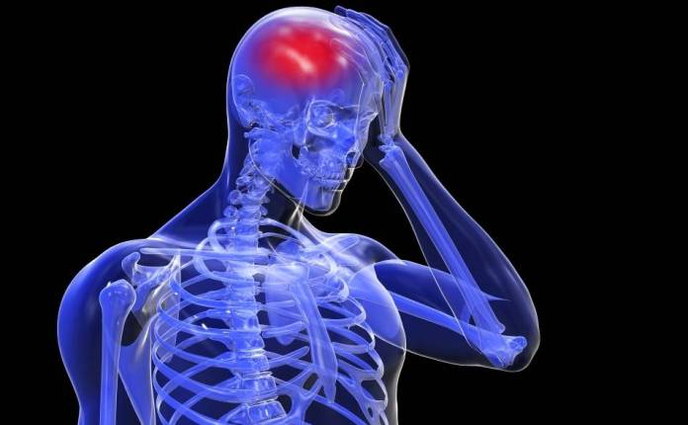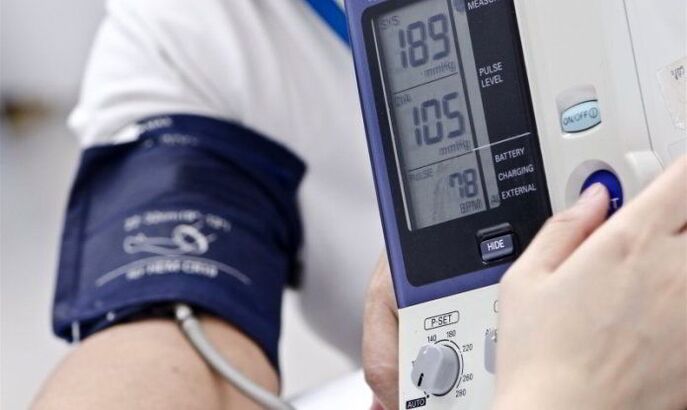Cervical osteochondrosis is a disease of the spine, which are characterized by disorders of the intervertebral discs.Pathology is characteristic of the elderly, but a person of any age can encounter it.Tangible discomfort causes one of the main signs of this disease - severe pain.The patient needs to know what cervical osteochondrosis is dangerous and what problems he will have to face.
The specifics of the disease
The cervical region is one of the most mobile parts of the body, and it encounters regular loads.With the development of osteochondrosis, the vertebrae shift, which leads to compression of numerous vessels and nerves.The main complexity of the pathology is that its characteristic dystrophic changes affect the roots of the spinal nerve and the disks of the intervertebral space.Because of this, the brain remains without the necessary oxygen, blood supply is lost.

In the risk zone, there are primarily elderly people in whom the disease develops against the background of metabolic disorders, and changes in the structure of vertebrae and intervertebral discs are age -related.The reason for the development of such violations can also be:
- salt deposition;
- insufficient physical activity;
- improper nutrition;
- injuries;
- frequent hypothermia;
- Hormones problems;
- Excess weight;
- Chronic diseases.
Osteochondrosis also provokes a long -term presence of the body in one position, which puts office employees and drivers under the blow of.
Symptoms of osteochondrosis
At the initial stage of the disease, the symptoms are almost invisible, anxiety can cause only mild pain in the neck.But as pathology develops, symptoms are gradually increasing.
Osteochondrosis of the cervical spine can be identified by the following signs:
- severe pain in the neck, nape, shoulders;
- regular migraines;
- weakness of hands;
- The mobility of the neck is limited;
- When turning the head, the vertebrae is crunched;
- Hearing problems;
- A characteristic ringing appears in the ears;
- Discomfort in the throat.
In the initial stages, the pain syndrome manifests itself only during movement, when tilted or turning the neck.Over time, the pain occurs even when the position of the hands changes.
Possible complications
If cervical osteochondrosis is not treated, degenerative processes on the intervertebral discs will lead to the loss of their main functions and a decrease in density.The excessive mobility of the spine will gradually develop, muscles, joints and ligaments will suffer.The pressure on the nerve endings and the spinal cord will only intensify, which will lead to an increase in symptoms and the development of new pathological phenomena.

Frequent migraines
To the most common consequences of osteochondrosis of the cervical spine, you can calculate a headache.This happens because it is on this site that the vertebral artery is located, which is responsible for the delivery of oxygen and blood to the brain.
As the disk strength changes, the amortizing functions are violated.Deformed vertebrae press on the artery, interfering with blood circulation and “delivery” of the necessary oxygen.Muscle cramps are developing.
Following pain, concomitant symptoms often follow:
- nausea;
- vomit;
- sharp increase in pressure;
- tingling in the shoulder blades;
- Weakness throughout the body.
With severe attacks, it is desirable to relax as much as possible, it is better in a horizontal position.An unpleasant syndrome can remove painkillers or cold compresses, while massage is useless.
Problems with vision
Complications of cervical osteochondrosis often affect the organs of vision: in this section of the spine there are sleepy and vertebral arteries, which are responsible for the blood flow to the visual central structure.Compression of nerve roots and blood vessels lead to hypoxia and cause a decrease in vision.
Together with the syndrome of the vertebral artery, symptoms such as:
- fog;
- darkening in the eyes;
- the appearance of "flies" or colored spots;
- bifurcation;
- excessive stress of the optic nerve;
- dizziness;
- nausea.

During the examination, a specialist may notice a narrowing of the arterial vessels of the eye retina, less often there is swelling of the optic nerves.Also, against the background of the disease, glaucoma may appear, accompanied by increased intraocular pressure and pain.
Hearing problems
Due to the compression of the vertebral artery and nerve roots, hearing loss is possible by 20-30%.The neglected cervical osteochondrosis can lead to even complete deafness.To avoid this, you must contact a doctor at the first symptoms of the disease.
A slight decrease in hearing is reversible: in addition to drug treatment prescribed by a doctor, the patient needs special exercises or massage of the ear shells.Watching TV or listening to music is better at a small volume to strain the hearing organs.
Hypotension or hypertension
Reduced or increased blood pressure are fairly common consequences of cervical osteochondrosis.The greatest danger is hypertension, which are characteristic:
- Ocomuation of the pulse;
- increased sensitivity to temperatures;
- sleep disturbances;
- nasal bleeding;
- dyspnea;
- heart pain;
- Sweating.
The higher the blood pressure, the greater the load falls on the heart, which leads to its rapid wear.As a result, heart failure develops.In hypertension, atherosclerosis develops faster, which is dangerous with a brain stroke.
Hypotenia does not pose a direct threat to life, but greatly affects its quality.The body experiences oxygen starvation, which affects the general well -being of the patient.Hypotonia is characterized by violations of venous and arterial blood supply, and this entails disturbances in the sensitivity of the limbs.Among the possible complications are myocardial infarction.

Vegetes -vascular dystonia
Vegetes -vascular dystonia is a general designation of the syndrome, which can affect several body systems and organs.Most of the pathology, the cardiovascular system and peripheral nerves suffer from pathology.The patient experiences constant anxiety and sharp emotional differences.Frequent panic attacks are also possible, and the heart rhythm becomes more frequent.
Symptoms of dystonia can be lubricated or disguised as other diseases.The consequences of osteochondrosis of the cervical region in this case are also not the most pleasant.So, the gastrointestinal tract often suffers: nausea and vomiting, diarrhea, constipation and severe abdominal pain are possible.Disorders of the gallbladder or liver are possible.Patients often complain of tachycardia, pressure problems and heart pain.
Intervertebral hernias
With an intervertebral hernia, fragments of the disk are “protruding” into the spinal canal or fall out.The initial stage of this pathology is called protrusion.The integrity of the intervertebral disc is not disturbed with it, but there is a slight protrusion of bones in the spinal canal.At this stage, the pressure on the roots of the spinal cord, so the main symptom is the weak pain that occurs during movement.In the later stages, pain syndrome is enhanced.
The mobility of the vertebrae is gradually reduced.The muscle tension is enhanced, even if the patient seems to be in a relaxed state.You can also note periodic weakness in the upper parts of the hands or in the wrists.The numbness of the hands appears, and a tingling tingling often occurs near the thumb.
This is what is dangerous osteochondrosis of the cervical spine with hernia: it has a serious load on the artery, which passes next to the vertebral column and is necessary for the correct blood supply to the brain.If an excessive pressure of the patient occurs, ischemic stroke can be expected.
A large hernia is dangerous to inflammation of the surrounding ligaments - this is fraught with cervical radiculitis.Only timely treatment can prevent complications.The patient needs to carefully listen to his body and at the first symptoms consult a doctor.Suspicions should cause:
- sharp attacks of nausea for no visible reasons;
- darkening in the eyes when moving;
- noise in the ears when turning the head;
- Pulling sensations in the neck with a long stay in a standing position.
The most serious complications are the risk of irreversible paralysis of one or both hands.The cerebral nerve atrophy leads to this, which is located in the cervical region.If the hernia begins to put pressure on the blood vessels, they will gradually die, which will lead to an innervation of a number of organs.
Vestibular-barrel syndrome
The vestibular-barrel syndrome is a condition in which the patient experiences a strong dizziness that accompanies the loss of orientation.
Attacks arise with a sharp rise, fast turning or throwing the head back.Characteristic of the state:
- noise in the ears;
- nausea;
- visual impairment;
- The feeling that everything is spinning and floating before his eyes.
The main reason for the pathology is the lack of blood supply, which entailed the dysfunction of the vestibular apparatus.The syndrome will occur more and more often as osteochondrosis develops.
Glorious minute syndrome
Launched osteochondrosis is dangerous with neuro-vascular disorders of the throat and larynx.The syndrome is characterized by:
- hoarseness;
- difficulties when swallowing;
- constant sensation of a coma in the throat;
- dryness and soreness;
- Complete loss of voice.
The syndrome occurs suddenly and is accompanied by dizziness.
Syndrome Bar Lieu
The second name of the pathology is the syndrome of the vertebral artery.The reason for its development is the stenosis (narrowing) of the vertebral canal, in which spasms of the vertebral artery and compression of blood vessels and nerves occur.
Symptoms include:
- hypertension;
- nausea;
- tachycardia;
- carving in the eyes;
- noise in the ears;
- loss of coordination of movements;
- pulsating pain in the temples or in the occipital region.
With a sharp movement or turning the neck, the patient may lose consciousness.

Hypotolamic syndrome
At the same time, the hypothalamus suffers from the syndrome - a part of the brain that is responsible for metabolism, pressure, sleep, body temperature and emotional reactions of a person.Functional disorders can be manifested by enhancing or weakening the activity of the brain department.In the first case, the patient becomes irritable, in the second - inhibited.
Symptoms often resemble neurasthenia, which manifests itself through:
- sleep disorders;
- resentment;
- irritability;
- high fatigue;
- Unstability of mood.
A person loses the opportunity to concentrate, there are problems with memorization.Unreasonable outbreaks of anger are possible, appetite disappears, libido decreases.
It is better to prevent any disease than to treat, to predict the behavior of osteochondrosis is quite difficult.If there are risk factors, you need to regularly perform a set of simple physical exercises that will increase the mobility of the vertebrae and eliminate the congestion in the collar area.
The frequent appearance of any of the described symptoms is the obvious signal of the body about the problems that occur in it.At the same time, self -medication is useless, and without consulting a specialist it will not work.
















































